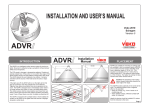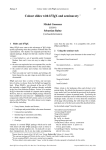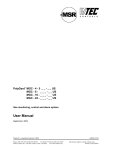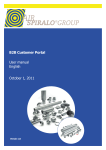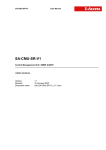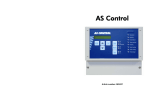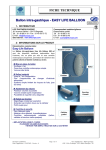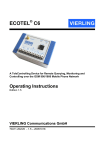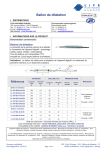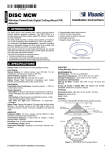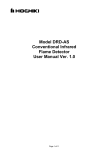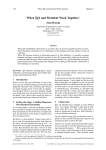Download INSTALLATION AND USER`S MANUAL
Transcript
INSTALLATION AND USER’S MANUAL
ADR-R
ADR-S
Veko 2012
Schagen
Version 1
ADR
INTRODUCTION
The ADR-S/R is a motion sensor system for
turning on lights. Movement is detected using a
pyroelectric infrared sensor (PIR).
The PIR reacts to changes in temperature
patterns. People and animals radiate heat. If they
enter or move within the range of the ADR-S/R
motion sensor, the heat patterns change within
this range. The ADR-S/R detects this and
interprets it as motion. It remains activated until
the source of the heat leaves the area or stops
moving.
The ADR-S/R is designed so that it does not
immediately switch off when it no longer senses
any motion; it uses a so-called delay switch.
The motion sensor has a timer, which resets
each time it detects movement. When the timer
runs out, the lights are switched off.
The ADR-S/R is also fitted with a twilight sensor,
which enables the system not to switch on the
lights if the amount of daylight exceeds a certain
level. This level can be set using a potentiometer.
ADR
Installation manual
ADR-S
Figure A:
PLACEMENT
0,0m
Fig.. B2
2,0m Fig. B
4,0m Sensor
range
6,0m width
Sensor
range height
8,0m
overlap
8
7
6
5
4
10,0m
3
2
1
0
1
2
3
4
5
6
7
ADR-R
ADR-R
Figure B:
6
5
4
3
2
METRES
3
2
1
0
1
0,0m
Sensor
2,0m range
4,0m width
Sensor
range height
overlap
7
8
12,0m
13,5m
2
3
Caution! Ensure that the rail is level,
both in the length and breadth (see
Fig. B2).
Caution! The sensitivity of the motion
sensor always deteriorates towards the
outer edge of its range.
Fig. B
6,0m
1
0
1
2
3
4
5
6
7
8
8,0m
METRES
3
2
1
0
1
2
ADR-S/Rs are suitable for mounting on lighting
rails. The standard ADR-R detection angle is
130 to 140°. The detection angle of the ADR-S
is restricted in terms of its width. This means that
the motion sensors will only activate if someone
moves into the narrow detection range (see
Fig. B) of the sensors that have been mounted
in a row.
The spacing between the sensors depends on
the railing height (see Fig. A). Take into account
the overlap between the sensors’ ranges (1m).
The higher the ceiling, the less sensitive the
motion sensors will be. The ADR-S/R functions
optimally in the centre of the room or passage.
3
Page 1
Installation
manual
ADR
CONNECTION
L
N
2x
N L L
3
Black
Blue
1
Brown
CEILING MOUNTING
C NC NO
2
2
OFF
1
Before you connect the ADR-S/R, turn the
mains off!
Standard connection: Connect phase (L) to the
brown wire, the switch wire (NO) to the black
wire and neutral (N) to the blue wire. When the
current is turned on, the lighting will always come
on.
The detector’s double-throw switch is potentialfree. 230 V is connected through a circuit
between L and C. In its standard setting, the NC
connection is not used.
To enable dimming (optional), a special dimmer
switch must be placed between the connection
and the wiring. This optional setting is described
on page 6.
Place the lid with the ADR in the rail (1). Turn the catch 90°
clockwise (2). If there is a reflector, take the catch off and
place the reflector between the catch parts. Click the catch in
place (3).
Page 2
ADR
40 sec
0
Installation manual
2 min
1
0
1
4 min
1
0
2
6 min
1
3
0
SETTINGS [1]
8 min
1
4
0
1
0
A
15 min
5
30 min
1
0
6
45 min
1
0
7
1
0
The ADR-S/R has 8 settings for the delayed-off
switch for motion detection, which can be
selected using switches 1 to 3. The standard
setting is A3 (6 min). Setting A0 has a very short
delay (only to be used to test the ADR-S/R and
the installation). The optional dimmer setting
described on page 6 does not affect switching or
the lifespan of the bulbs.
Caution! Do not set the delay switch to
less than 15 minutes for vapour lamps!
Short switch times have a negative
effect on the lifespan of these lamps because
they are not given enough time to warm up. If the
lighting remains dimmed, the switch time can be
shorter (page 6).
Motion detection
Page 3
ADR
Installation manual
1
0
B
0
1
0
norm: 0-100%
0
C
D
3
2
1
+ +
1
+
0
<15 min: 100%
>15 min: 35-100%
1
1
1
0
0
0
1
1
1
0
ADR
SETTINGS [2]
0
norm
1
-
0
-
-
PIR sensitivity (B)
The ADR-S/R has two sensitivity settings for
motion detection: switch on and continuous.
The switch on sensitivity setting applies to the
first detection (lighting is off).
The continuous sensitivity setting applies after an
initial detection and throughout the set delay
time.
The standard setting is B0 (normal sensitivity).
Use the less sensitive settings if the lighting
comes on unnecessarily or does not switch off
properly.
Switch on setting (C)
If the ambient temperature is low, for example, in
a cold room, there is an option that allows the
bulbs to first burn fully for a time (C1). The
lighting will initially be switched on for 15 minutes
and will then be dimmed to between 35 and
100% {ADR-SD/ADR-RD}.
Switch on setting (D)
If the light cell does not operate as desired, for
example, because the detector is in an area
where there is a lot of light, there is an option to
deactivate the light cell (D0).
Dipswitch 8 does not have a function.
+ + Degree of detection sensitivity
Page 4
Installation manual
SETTINGS [3]
1000 lux
E
Twilight switch
The ADR-S/R comes with a twilight switch.
This ensures that the lighting is not turned on
if there is sufficient daylight in the room.
If this is the case, and the daylight level drops
below the set value while the room is still
occupied, the lighting will turn on. If the lighting is
on and the amount of daylight rises above the
set value, the lighting will stay on. This prevents
unnecessary switching on and off. Turn clockwise for higher twilight value and counterclockwise for a lower twilight value. A higher
twilight value means that more daylight is
required to stop the lights from turning on.
Onset of twilight
35 lux
Page 5
ADR
Installation manual
DIMMING (OPTIONAL)
L
N
1
0
1
0
40%
4
3
N L
2
5
35%
1
0
1
0
25%
F
All installation instructions must be followed.
If in doubt, consult VEKO lightsystems technical
services department.
Ensure that the wires are connected according to the
colour coding.
The ADR-S/R is not certified for use as an alarm
system.
Page 6
Fault
Possible cause
TECHNICAL SPECIFICATIONS
Solution
Lighting is not
switching on
No current
Twilight value not yet reached
Bulb defective
check mains
adjust settings
replace
Lighting is
switching on
unnecessarily
Switches on after loss of current
Sudden change in heat patterns (e.g.,
printer, fan, air conditioning etc.) within
detection range
wait
choose a better site
lower sensitivity
Lighting is
switching off
unnecessarily
No detection within set delay time
choose longer delay
Person is outside detection range
choose a better site
use more detectors
set the delay to longer
The detector is higher than 12 metres
mount the detector lower
No current
reset mains
Switch is overridden by installation switch
turn switch off
Heat patterns within detection range are
constantly changing
choose a better site
Comply fully with the technical specifications of the
equipment.
Do not use ‘cold start’ switches if the ADR-S/R is likely
to switch on the lighting more than twice in a 24-hour
period.
Dimmer adjustment
The dimmer can be set using the DIP-switches
on the dimmer module. There are 6 dimming
levels: 100%, 50%, 40%, 35%, 25% and 15%.
The DIP positions are shown here and on the
dimmer module.
1
0
TROUBLESHOOTING
SAFETY
Only certified electricians are permitted to work on
230V mains.
1
Place the dimming-module between the
connections and the wiring. Connect phase (L)
to the brown wire, neutral (N) to the blue wire
and the switch wire to (1-10 V).
6
15%
Before you connect the ADR-S/R, the current must be
turned off.
0V
50%
1-10 V
1
0
Blue
100%
3
Brown
2
1
Before you connect the ADR-S/R, turn the
mains off!
Lighting on
permanently
Lighting is not
switching off when Never switches off with sufficient daylight
there is sufficient
daylight
leave the room and wait until the delay
switch time passes
Nominal voltage:
Maximum continuous
power:
Usage (switched on/off):
PIR detection angle
Switched off time delay:
Ambient temperature:
(In deep-freeze mode):
Appliance class:
Lux values:
230 V ~ ± 10%, 50 Hz
9 A at cos = 1
[3 A at cos = 0,4]
< 0,22 W / < 4 W
All round 130° - 140°
5 sec.- 30 Min.
[motion]
0-40 °C
-25-40 °C
IP20/54
Minimum 35 lux
Maximum 1,000 lux
Design subject to alterations.
Rev.1 April 2012





